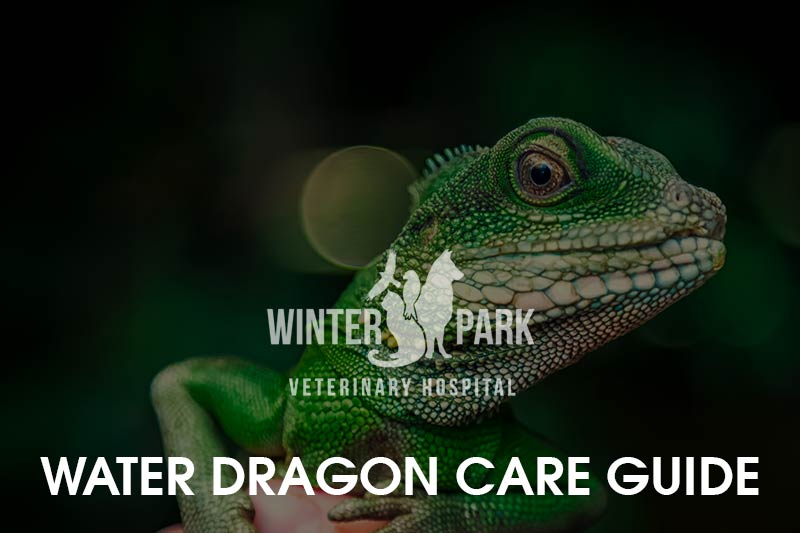Download Water Dragon Care Guide – PDF
Species Name
Physignathus cocincinus, Green water dragon, Asian water dragon, Physignathus lesueurii, Eastern water dragon.
Housing
Though hatchling water dragons can initially be housed in 10 to 20-gallon all-glass aquariums, they will soon need larger accommodations. A single adult green water dragon will require at least a 55-gallon aquarium, a pair will require at least a 100-gallon aquarium. A screen top that can be safetly secured to the aquarium should be used. NEVER use sand, kitty litter, moss, pine or cedar wood chips, or sawdust as a substrate, as these can be ingested by the water dragon and cause fatal intestinal obstructions. Newspaper or artificial turf can be used as a substrate if it is frequently changed. Orchid bark can also be used as substrate, which will help maintain humidity levels, but feces will need to be scooped out daily and the entire substrate changed on a frequent basiss.
Water dragons are semi-aquatic, so a large water area that the dragon can swim in is a necessary part of the habitat. A submersible aquarium heater can be used to maintain the water temperature at the ideal 77ºF. The water needs to be changed on a daily basis, or be filtered, in which case it will still need to be changed on a weekly basis. The humidity level of the enclosure should be from 80-100 percent. A simple hygrometer, available at most pet stores, can monitor the humidity level. The humidity level in a normal, air-conditioned house is very low, and the habitat will require a source of moisture to increase the humidity level. Humidity can be increased by commercial misters, foggers, or by daily misting of the enclosure. Never reduce ventilation to increase humidity.
Heating
Heat should be provided through heat lamps or ceramic heat emitters. By placing the heat source above one end of the enclosure, a thermal gradient can be created, so that the water dragon can choose the most appropriate temperature. A thermometer should be placed at each end of the enclosure to monitor the temperature. The temperature gradient should range from 77ºF at the cool end to 95ºF at the warm end. At night, the heat source may be turned off, so long as the temperature remains between 72ºF and 77ºF. The use of heat rocks and heating pads is NOT recommended, as these can cause serious thermal burns.
Lighting
Ideally, water dragons should be provided at least 2 hours of unfiltered sunlight (glass will filter UV light) to provide the UV light necessary for normal metabolic function. When this is not practical, an artificial UV light must be provided. The light should be turned on for 12-14 hours of the day. A light timer can be used to turn on and off the lights at set times every day. Only use UV bulbs specified for reptiles that provide both UV-A and UV-B rays. UV bulbs will need to be replaced every 6 months, as they begin to lose their efficacy after that.
Feeding
Water dragons are mainly insectivorous, though they should also be offered some plant matter. Hatchlings and juveniles should be fed every 2 days, while adults may be fed every 3 to 4 days. A variety of gut-loaded insects such as crickets, mealworms, and waxworms should be offered (See the “Gut-Loading” handout for an explanation of this procedure). Food items should be no longer than the length of the water dragon’s head, and no wider than half the width of the head. Plant matter offered should also vary, and can include mixed vegetables, strawberries, kiwi, melon, and banana.
Two types of supplement must be added to the water dragon’s food items. A calcium supplement, such as commercially available reptile calcium powders (such as ReptiCal™), crushed Tums™, or crushed cuttlebones, should be dusted on food at every other feeding. A multi-vitamin supplement (such as Nekton-Rep™, or ReptiVite™ should be dusted on food once weekly.
Reference
- Divers, S. “Water Dragons,” From http://www.petplace.com, 2005.
- De Vosjoli, P. Green Water Dragons. Mission Viejo, CA: Advanced Vivarium Systems, Inc., 1992. http://www.avsbooks.com









